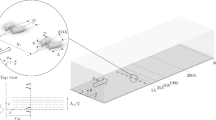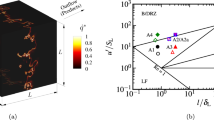Abstract
The paper presents experimental and numerical investigations of the Combustion Induced Vortex Breakdown (CIVB) in a free straight turbulent vortex. The velocity field was measured using the Laser-Doppler Velocimetry (LDV) and Particle Image Velocimetry (PIV) methods. The flame propagation is estimated from analysis of pictures taken by a high speed camera. Numerical simulations have been performed using the Large Eddy Simulations (LES). Two different types of the flame propagation along the vortex were identified depending on the equivalence ratio and the swirl number. It was shown that the Combustion Induced Vortex Breakdown takes place if the swirl number exceeds a certain threshold at a constant value of the equivalence ratio. LES simulations confirmed the fact that the CIVB appears in the vortex configuration considered. Detailed analysis of the LES data allows to estimate contributions of different physical mechanisms to the CIVB.
Zusammenfassung
Dieser Artikel stellt experimentelle und numerische Untersuchungen des Verbrennungsinduzierten Wirbelaufplatzens (Combustion Induced Vortex Breakdown, CIVB) in einem freien, geraden Wirbel vor. Das Geschwindigkeitsfeld wurde mit Hilfe von Laser-Doppler-Anemometrie (LDA) und Particle-Image-Velocimetry (PIV) vermessen. Die Flammenausbreitungsgeschwindigkeit wurde aus Hochgeschwindigkeits-Filmaufnahmen abgeschätzt. Die numerischen Simulationen basieren auf der Large-Eddy-Simulation (LES). Zwei verschiedene Arten der Flammenausbreitung entlang des Wirbels wurden identifiziert, abhängig vom Äquivalenzverhältnis und der Drallzahl. Es wurde gezeigt, dass das Verbrennungsinduzierte Wirbelaufplatzen auftritt, wenn die Drallzahl eine kritischen Schwelle bei konstantem Äquivalenzverhältnis überschreitet. Die LES-Simulationen haben bestätigt, dass CIVB in dem untersuchten Fall auftritt. Eine detaillierte Analyse der LES-Daten erlaubt es, die Beiträge unterschiedlicher physikalischer Mechanismen zum CIVB abzuschätzen.
Similar content being viewed by others
References
Ashurst WT (1996) Flame propagation along a vortex: the baroclinic push. Combust Sci Technol 112:175–185
Chomiak J (1977) Dissipation fluctuations and the structure and propagation of turbulent flames in premixed gases at high reynolds numbers. In: Sixteenth Symposium (International) on Combustion
Fritz J (2003) Flammenrückschlag durch verbrennungsinduziertes Wirbelaufplatzen. PhD thesis, Technical University of Munich
Günther R (1984) Verbrennungen und Feuerungen. Springer, Berlin
Hasegawa T, Michikami S, Nomura T, Gotoh D, Sato T (2002) Flame development along a straight vortex. Combust Flame 129:294–304
Hasegawa T, Nishikado K (1996) Effect of density ratio on flame propagation along a vortex tube. In: Twenty-Sixth Symposium (International) on Combustion, pp 291–297
Ishizuka S, Murakami T, Hamasaki T, Koumura K, Hasegawa R (1998) Flame speed in combustible vortex rings. Combust Flame 113:542–553
McCormack PD, Scheller K, Mueller G, Tisher R (1972) Flame propagation in a vortex core. Combust Flame 19:297–303
Kornev N, Hassel E (2007) Method of random spots for generation of synthetic inhomogeneous turbulent fields with prescribed autocorrelation functions. Commun Numer Meth Eng 23:35–43
Sakai Y, Ishizuka S (1996) The phenomenon of flame propagation in a rotating tube. In: Twenty-Sixth Symposium (International) on Combustion, pp 847–853
Umemura A, Tomita K (2001) Rapid flame propagation in a vortex tube in perspective of vortex breakdown phenomena. Combust Flame 125:820–838
Weller HG, Tabor G (2004) Large eddy simulation of premixed turbulent combustion using Ξ flame surface wrinkling model. Flow Turbul Combust 72(1):1–27
Weller HG, Tabor G, Gosman AD, Fureby C (1998) Application of a flame-wrinkling LES combustion model to a turbulent mixing layer. In: Proceedings of the 27th Combustion Symposium, pp 899–907
Weller HG, Tabor G, Jasak H, Fureby C (1998) A tensorial approach to computational continuum mechanics using object orientated techniques. Comput Phys 12(6):620–631
Author information
Authors and Affiliations
Corresponding author
Rights and permissions
About this article
Cite this article
Kröger, H., Kornev, N., Wendig, D. et al. Premixed flame propagation in a free straight vortex . Forsch Ingenieurwes 72, 85–92 (2008). https://doi.org/10.1007/s10010-008-0070-3
Received:
Published:
Issue Date:
DOI: https://doi.org/10.1007/s10010-008-0070-3




